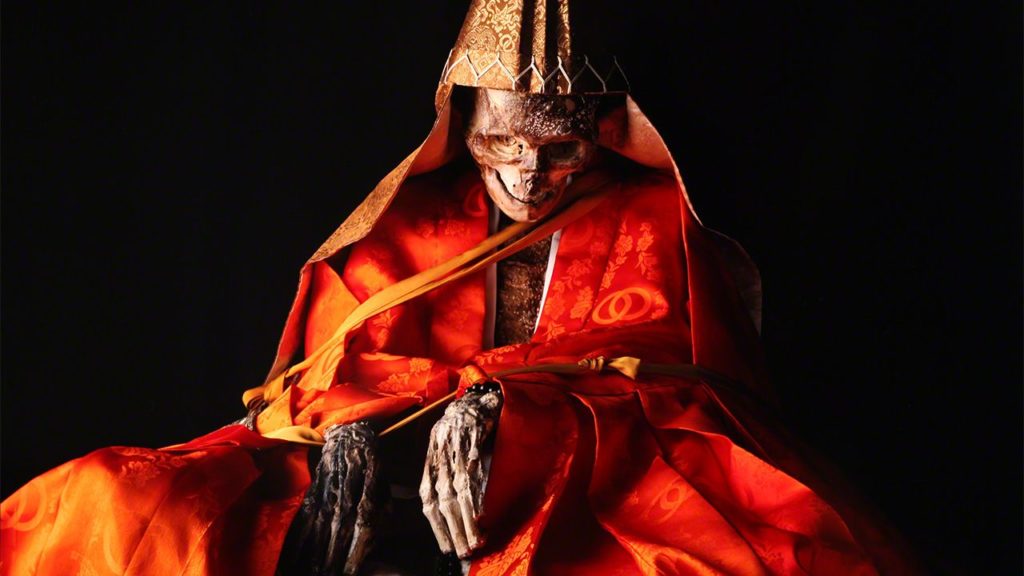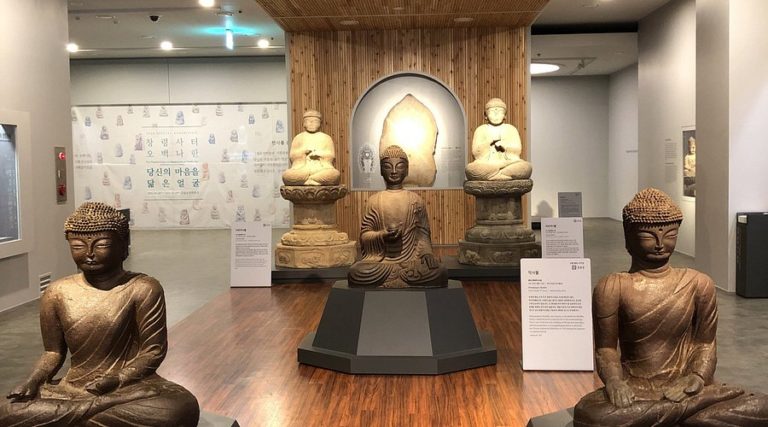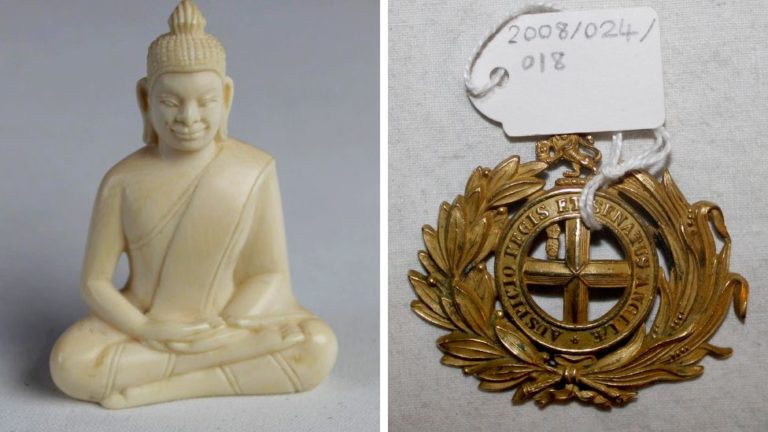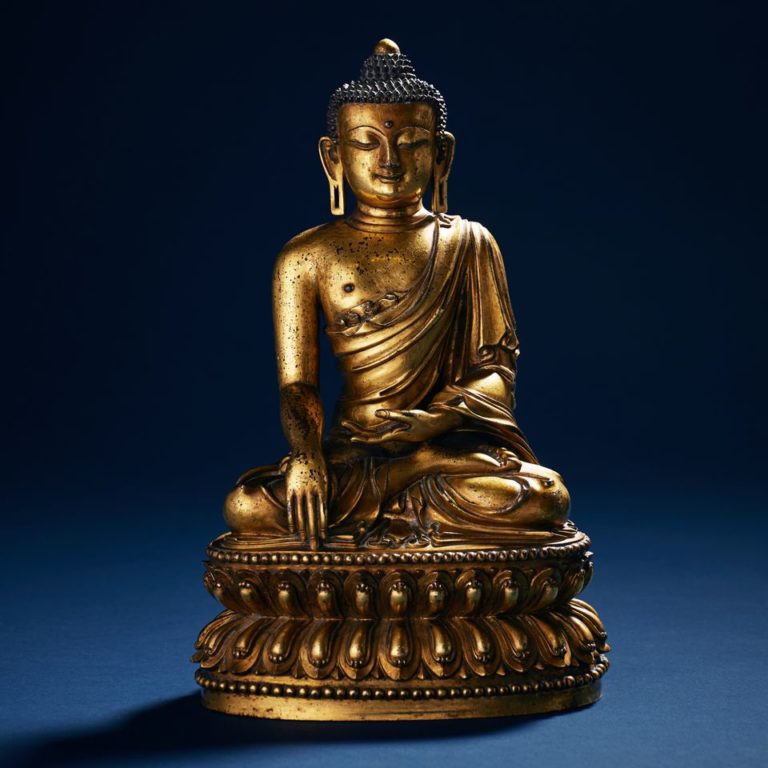Enclosed in a shrine, the skeletal frame of a man is posed in meditation, legs crossed beneath bright abbot’s robes while his bony hands rest on top. Thin, leathery skin stretches across what’s visible of his body.
At first glance, what springs to mind is a single word: mummy.

But to devotees of ascetic Buddhist practice in Japan, this is much more than a mummified human being. He is a sokushinbutsu (即身仏)—a so-called “living” or “instant” Buddha—who achieved a state of deep meditation that places him beyond the bounds of life or death.
To do so, he engaged in a series of rigorous ascetic practices, culminating in self-mummification. Shrines with other sokushinbutsu can be found around Japan, with more than half the known sokushinbutsu around the sacred mountains of Yamagata prefecture. How did this practice emerge, and why did so many choose to become sokushinbutsu? This is the real story of Japan’s self-mummified monks.
How does one become a sokushinbutsu?
The practice is linked to a sect of esoteric Japanese Buddhism called Shugendo, which has its roots in ancient mysticism, shamanism, and mountain worship.
“Shugendo roughly translates as ‘the way of cultivating special powers,” says Caleb Carter, associate professor of Japanese religions and Buddhist studies at Kyushu University. “These powers were allegedly acquired by Buddhist priests who performed austerities in the mountains such as ablutions under freezing waterfalls, meditation in caves, and severe dietary restrictions during extended periods of seclusion.”
The birth of sokushinbutsu remains tangled in a blend of recorded knowledge and myth.
The story goes that the monk Kōbō Daishi studied esoteric Buddhism in China and brought back what he learned to Mount Yudano in Yamagata, then Mount Kōya in Wakayama prefecture, leaving a lasting impact on Shugendo and other forms of esoteric Buddhism in Japan. According to legend, Kūkai is the first sokushinbutsu and is still alive—in deep meditation—in Mount Kōya. The link between the sokushinbutsu and sacred mountains remains a through line in becoming a living buddha.
“Mountains have long been believed to be the dwelling places of local gods, demonic forces, auspicious dragons, even buddhas and bodhisattvas,” Carter explains. Like other practitioners and devotees, those aiming to become sokushinbutsu went to these sacred places “to master their terrain, receive the right ritual knowledge, and successfully mingle with their deities—even become deities in the process.”
How each monk approached becoming a sokushinbutsu varied. Generally, after becoming a member of one of the temples or seminaries and living a devout life, the monk choosing to reach this form of enlightenment would enter seclusion. He would partake in a centered on abstaining from grains. For some, this meant eating only tree bark, pine needles, pine cones, seeds, chestnuts or even stones and crystals for a period of a thousand or several thousand days.
There are no known women sokushinbutsu as women weren’t allowed to enter many sacred spaces, including the summit of sacred mountains, for much of history. Today, rules have changed and there are a number of female priests in various Buddhist sects in Japan.
After fasting, monks would entomb themselves in a stone chamber underground or in a coffin, chanting prayers until they passed on. Some were left underground for three years, then exhumed in a preserved state before being placed in the temple. Others were exhumed immediately upon their deaths and dried using charcoal and incense smoke, then reburied and left underground for three years before being placed in shrines.
It’s not clear how many sokushinbutsu have existed throughout history. The process of self-mummification is such that there is no way of knowing how many monks attempted it and failed, their unpreserved bodies left to decay and disappear. However, in the 1960s, Japanese researchers credited for rediscovering and studying the sokushinbutsu in the region documented 21, with written records of others whose physical remains no longer exist.
The highest concentration of sokushinbutsu (13 of 21) are in Yamagata prefecture, scattered in temples around Mount Yudano, part of the sacred Dewa Sanzan, along with Mount Haguro and Mount Gassan.
While their practice may seem unthinkably extreme, sokushinbutsu exist as part of a larger religious framework that includes other ascetic acts requiring physical exertion and endurance. Today, you can still participate in ascetic acts—like firewalking, climbing a sword ladder in bare feet, and cold endurance—as a layperson at festivals, temples, or sacred sites. Similar acts also exist in Taoism and Buddhism practiced in India, both of which also influenced the historical development of Shugendo.
For most, participation in these physically difficult—and often painful—acts draw the mind and spirit into focus.
Becoming sokushinbutsu for the benefit of others
The oldest of the Dewa Sanzan sokushinbutsu is Honmyokai, who entered deep meditation in 1683. Originally a retainer to a feudal lord, it’s said he joined a Yudano seminary to pray for his lord’s recovery from a deathly illness. To become a sokushinbutsu, he began living in seclusion where he ate an ascetic diet of pine needles for nearly a decade. When he was near death, he entered a stone chamber and chanted a prayer until he passed on. Folklorist and researcher Ichiro Hori, who was part of the original team of researchers studying the sokushinbutsu, notes that Honmyokai’s desire was to free people from suffering and illness.
The most well-known of the Dewa Sanzan sokushinbutsu is Tetsumonkai, who became a sokushinbutsu in 1829. While his origin story varies slightly depending on the source, it’s generally believed he killed two samurai and fled to a temple, beginning a life of ascetic practice. He also traveled throughout northern Japan, providing spiritual guidance and even medical support through his knowledge of herbs. Like Honmyokai, altruism is a theme through Tetsumonkai’s story. During the Edo period, an illness that attacked the eyes spread, reaching an epidemic. According to Hori, Tetsumonkai purportedly gouged out one of his own eyes as an offering to the Mount Yudano deities to save those suffering from the disease. Following the precedent set by those who came before him, Tetsumonkai fasted and entered deep meditation, becoming a Buddha enshrined in Churen-ji Temple.
There are many other sokushinbutsu who have existed and many whose stories have been lost to time. Each we have records of decided to undergo the process for unique, personal reasons. Yet, the process is often done for altruistic reasons, whether for the benefit of an individual, a village or for society at large.
The rationale for becoming a sokushinbutsu seems, therefore, not simply to accomplish the act for its own sake, but rather for what the practitioner can achieve for others—both during their mortal lives and in their afterlives as living Buddhas.




